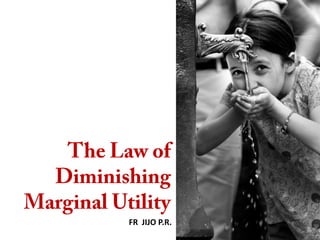
Diminishing marginal utility
- 1. FR JIJO P.R.
- 2. Introduction Utility is a measure of satisfaction, referring to the total satisfaction received by a consumer from consuming a good or service Utility measures the want-satisfying power of a good or service(usefulness) Marginality The term marginal refers to a small change, starting from some baseline level. Marginal Utility of a good or service is the utility gained from an increase, or lost by a decrease, in the consumption of that good or service. Marginal utility is the additional or incremental satisfaction (utility) a consumer receives from acquiring one additional unit of a product.
- 3. Definition of Law of Diminishing Marginal Utility The law of diminishing marginal utility states that ‘as a consumer consumes more and more units of a specific commodity, utility from the successive units goes on diminishing’. • Mr. H. Gossen, a German economist, was the first to explain this Law in 1854. • Alfred Marshall later on restated this Law as follows: “The additional benefit which a person derives from an increase of his stock of a thing diminishes with every increase in the stock that he already has”.
- 4. • Explanation and Example of Law of Diminishing Marginal Utility: • Suppose, a man is very thirsty. He goes to the market and buys one glass of sweet water. The glass of water gives him immense pleasure or we say the first glass of water has great utility for him. • If he takes second glass of water after that, the utility will be less than that of the first one • If he drinks 3rd glass of water the utility declines again and so on….
- 5. Schedule of Law of Diminishing Marginal Utility Units Total Utility Marginal Utility 1st glass 20 20 2nd glass 32 12 3rd glass 40 8 4th glass 42 2 5th glass 42 0 6th glass 39 -3 From the above table, it is clear that in a given span of time, the first glass of water to a thirsty man gives 20 units of utility. When he takes second glass of water, the marginal utility goes on down to 12 units; When he consumes fifth glass of water, the marginal utility drops down to zero and if the consumption of water is forced further from this point, the utility changes into disutility (-3).
- 6. Curve/Diagram of Law of Diminishing Marginal Utility: In the figure (2.2), along OX we measure units of a commodity consumed and along OY is shown the marginal utility derived from them. The marginal utility of the first glass of water is called initial utility. It is equal to 20 units. The MU of the 5th glass of water is zero. It is called satiety point. The MU of the 6th glass of water is negative (-3). The MU curve here lies below the OX axis. The utility curve MM/ falls left from left down to the right showing that the marginal utility of the success units of glasses of water is falling.
- 7. Assumptions of Law of Diminishing Marginal Utility • The law is true under certain assumptions as follows: • (i) Rationality: The consumer aims at maximization of utility subject to availability of his income. • (ii) Constant marginal utility of money: The marginal utility of money based for purchasing goods remains constant. • (iii) Diminishing marginal utility: The utility gained from the successive units of a commodity diminishes in a given time period. • (iv)Utility is additive: The utilities of different commodities are independent.
- 8. • (v) Consumption to be continuous • (vi) Suitable Reasonable quantity: If the units are too small, then the marginal utility instead of falling may increase up to a few units. • (vii) Character of the consumer does not change. • (viii) No change to fashion, Customs and Tastes. • (ix) No change in the price of the commodity.
- 9. Practical Importance of Law of Diminishing Marginal Utility • (a) Diversification in Production: To overcome the resistance of the consumers towards using the same kind of good and in order to secure higher profits, the producers continuously introduce newer varieties of the products with new design, shape, colour, technique and presentation. • (b) Household Expenditure: Since larger purchases reduce marginal utility, we restrict the purchase of a particular commodity. We stop further purchases at a point, where marginal utility equals price.
- 10. • (c) Pattern of Public Expenditure: The public expenditure should be planned in such a manner that more is spent for the benefit of the poor. The law of diminishing marginal utility provides justification of the socialist plea for an equitable distribution of wealth. • (d) Basis for Progressive Taxation: Progressive taxation results when the rate of taxation increases with an increase in income of the consumer. As the rich have lower marginal utility of money as compared to the poor people due to greater stock of money, they should be taxed at a higher rate.
- 11. Limitations/Exceptions of Law of Diminishing Marginal Utility (i) Case of intoxicants: The more a person drinks liquor, the more s/he likes it. (ii) Rare collection: If there are only two diamonds in the world, the possession of 2nd diamond will push up the marginal utility. (iii) Application to money: It is true that more money the man has, the greedier he is to get additional units of it. However, the truth is that the marginal utility of money declines with richness but never falls to zero. Conclusion • we can say that the law of diminishing utility, like other laws of Economics, is simply a statement of tendency. It holds good, provided other factors remain constant.